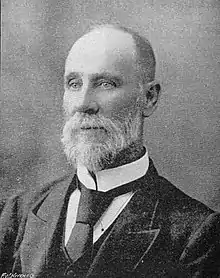Samuel Mitchell | |
|---|---|
 | |
| Member of the Legislative Council of Western Australia | |
| In office 27 October 1884 – 28 May 1885 | |
| Preceded by | John Davis |
| Succeeded by | Edward Wittenoom |
| Constituency | Geraldton |
| Member of the Legislative Assembly of Western Australia | |
| In office 26 May 1897 – 24 April 1901 | |
| Preceded by | E. T. Hooley |
| Succeeded by | John Nanson |
| Constituency | Murchison |
| Personal details | |
| Born | c. 1838 Redruth, Cornwall, England |
| Died | 5 July 1912 Northampton, Western Australia |
| Resting place | Gwalla Cemetery, Northampton[1] 28°21′28″S 114°38′16″E / 28.3579°S 114.6378°E |
| Spouse(s) | Mary Jane Stephens, Hannah Corey |
Samuel Mitchell (c. 1838 – 5 July 1912) was an Australian businessman and politician who was a pioneer of the mining industry in Western Australia. He served in both houses of the Parliament of Western Australia, as a member of the Legislative Council from 1884 to 1885 and a member of the Legislative Assembly from 1897 to 1901.
Early life and business career
Mitchell was born in Redruth, Cornwall, the son of a mining engineer, and worked in the Cornish tin mines from a young age. From there he was recruited as mine captain for the Geraldine Lead Mine, located on the Murchison River near Northampton, the first commercial mine in the colony. He, his brother James and a party of seven Cornish miners arrived at Fremantle on the Zephyr on 13 November 1867.[2][3][4] Mitchell later opened the Wheal Ellen and Badra lead mines, near Northampton, and in 1872 was elected to the Mines Roads Board. He served as chairman of the roads board from 1876 to 1879, and eventually left the mining business, settling down in Northampton as a storekeeper, stock agent and Justice of the Peace.[5][6]
Politics
In 1884, Mitchell was elected to the Legislative Council, representing the seat of Geraldton. However, he served for less than a year before resigning, having never been sworn in and never attending a council meeting.[7] At the 1897 state election, Mitchell was returned to parliament as a member of the Legislative Assembly, representing the seat of Murchison. He was defeated by John Nanson at the 1901 election, and was also defeated by Nanson in a ministerial by-election later in the year.[8] At the 1904 state election, both Mitchell and Nanson contested the seat of Greenough, which was adjacent to Murchison but considered more winnable. Mitchell placed third with 21.9 percent of the vote, behind Nanson (35.0 percent) and the sitting member, Patrick Stone (25.6 percent).[9]
Later years
Mitchell published an autobiography in 1911 (Looking Backwards: Reminiscences of Forty-Two Years), and died at his home, Chiverton House, Northampton in July 1912. He had married twice, both to Cornishwomen, and had 21 children – ten by his first wife, and eleven by his second.[6] One of his grandsons was Sir David Brand, who became 19th Premier of Western Australia.[10]
References
- ↑ "Death of an Old Colonist". The West Australian. Perth, WA. 11 July 1912. p. 6. Retrieved 16 June 2018.
- ↑ "Shipping Intelligence". The Herald. Fremantle, WA. 16 November 1867. p. 3. Retrieved 17 June 2018.
- ↑ "Looking Backward". Geraldton Express. 10 July 1912. p. 3. Retrieved 16 June 2018.
- ↑ "Shipping Intelligence". The Herald. Fremantle, WA. 16 November 1867. p. 2. Retrieved 8 January 2018.
- ↑ "Death of Mr. Samuel Mitchell". Geraldton Guardian. 6 July 1912. p. 3. Retrieved 8 January 2018.
- 1 2 "Samuel Mitchell". Biographical Register of Members of the Parliament of Western Australia. Parliament of Western Australia. Retrieved 17 June 2018.
- ↑ "Mr Samuel Mitchell M.L.C.", The Herald (Fremantle), 6 June 1885.
- ↑ Black, David; Prescott, Valerie (1997). Election statistics: Legislative Assembly of Western Australia, 1890-1996. Perth, W.A.: Western Australian Parliamentary History Project and Western Australian Electoral Commission. ISBN 0730984095.
- ↑ Greenough (1,151), The Western Mail, 2 July 1904.
- ↑ "David Brand". Biographical Register of Members of the Parliament of Western Australia. Parliament of Western Australia. Retrieved 17 June 2018.